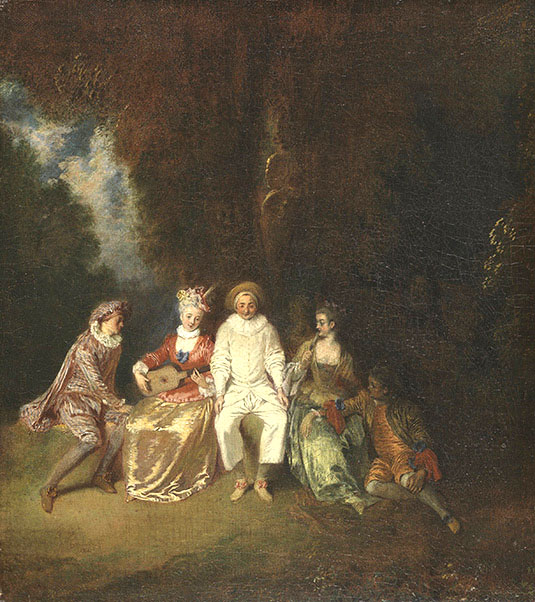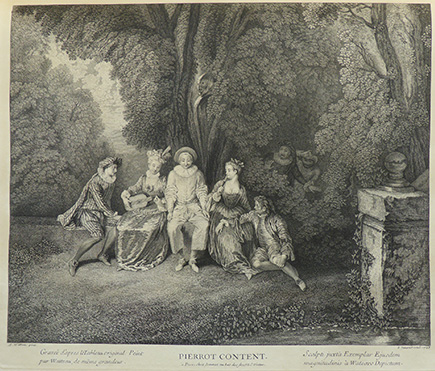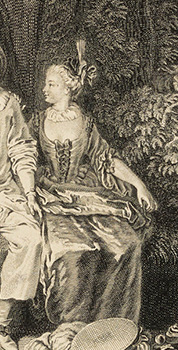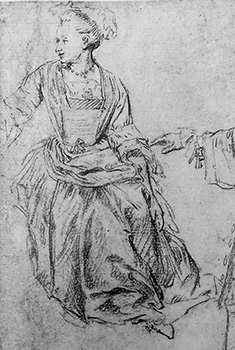
- Home Page
- Accepted
Paintings & Copies - Doubtful
Attributions - Doubtful Textual References
- Alternative
Titles - Collectors &
Museums - Bibliography
- Search Abecedario
- Watteau &
His Circle
Pierrot content
Entered November 2023; revised 2025
Madrid, Museo Nacional Thyssen-Bornemisza, Inv. no. 432 (1977.75)
Oil on canvas
35 x 31 cm
ALTERNATIVE TITLES
Cinq Figures de caractère, assises dans un jardin
Pierrot contento
Société galante dans un parc
RELATED PRINTS

Edmé Jeaurat after Watteau, Pierrot content, engraving, 1728.
The picture was engraved in the same direction by Edmé Jeaurat in 1728.
PROVENANCE
Paris, collection of Baron Karl Heinrich von Heineken (1707-1791). His sale, Paris, December 12, 1757 - February 18, 1758, lot 144: "Un Jardin, dans lequel on voit cinq Figures de caractere comique, dont une femme jouant de la guitare; Tableau peint sur toile de treize pouces de haut sur seize de large" according to annotated copies of the sale catalogue, the painting sold to the sculptor Michel Ange Slodtz bidding for for Perrier.
Paris, collection of Marie-Élizabeth-Geneviève Durey de Vieuxcourt, La Présidente de Bandeville (1721–1784). His sale, Paris, December 3, 1787, lot 47: "ANTOINE WATTEAU . . . Cinq Figures de caractere, assises dans un jardin & formant un grouppe. Ce Tableau peint sur toile, porte 13 p. de haut sur 16 pouces de large." According to an annotated copy of the sale catalogue in the Rijksbureau voor Kunsthistorische Documentatie, the painting sold for 373 livres.
Paris, collection of Jean-Joseph-Pierre-Augustin Lapeyrière (1779-1831; financier). His sale, Paris, April 3ff, 1832, lot 51: "WATTEAU (ANT.) -- Société galante dans un parc. Assise sur un banc de gazon, une jeune dame joue de la guitare. A ses côtés sont placés deux hommes, l'un aussi épris de ses charmes que de son talent, l'autre tout rayonnant de plaisir; celui-ci est vêtu en pierrot. Le succès de la jolie musicienne inspire de la jalousie à un autre femme, sur les genoux de laquelle s'appuye familièrement celui dont elle a gagné le coeur. Il ne faut pas être grand connoisseur pour sentir tout ce qu’il y a de finesse, de naturel, d’expression, dans ce joli tableau. T., h. 13 p., l. 12 p.” According to an annotated copy of the sale catalogue in the Rijksbureau voor Kunsthistorische Documentatie, the painting sold for 229 francs.
Boston, collection of Mrs. Robert S. Russell by 1917, then to Henry Cary, New York; then to Thomas G. Cary, New York, and to Mrs. Charles Pelham Curtis (née Caroline Cary). The Russells, Carys, and Curtises were three old Boston families related by marriage.
Boston, collection of Charles Pelham Curtis IV (1891-1959; lawyer and author). In his collection by 1939, this picture hung in the Boston Museum of Fine Arts almost every summer.
New York, Newhouse Gallery, bought from Charles P. Curtis. Sold in 1952 to a Houston, Texas, collector, who later sold it back to the Newhouse Gallery. Stolen c. 1972 in a New York
airport during shipment to New York. Recovered in 1976 according to information provided by Marco Grassi, who then restored the painting. Sold to Baron Thyssen-Bornemisza.Lugano, Switzerland, collection of Baron Heinrich Thyssen-Bornemisza (1875-1974; industrialist), as of 1977.
EXHIBITIONS
Boston, Museum, Art in New England (1939), cat. 138 (as by Watteau, Pierrot content, lent by Charles P. Curtis).
Cambridge, MA, Fogg Art Museum (1941) (without a catalogue).
Washington, D. C., International Exhibitions Foundation, Old Master Paintings (1979), cat. 51 (as by Watteau, Pierrot Content, lent by Baron Thyssen-Bornemisza).
Paris, Petit Palais, Collection Thyssen-Bornemisza, maîtres anciens (1982), cat. 52.
Moscow, Pushkin Museum, Masterpieces of the Collection of Baron Thyssen-Bornemisza (in Russian). cat. 37.
New York, Metropolitan Museum, Watteau, Music, and Theater (2009), cat. 2 (as by Watteau, Pierrot content, lent by the Museo Thyssen-Bornemisza, Madrid).
SELECT BIBLIOGRAPHY
Mariette, “Notes manuscrites,” 9, fol. 193.
Goncourt, L’Art au XVIIIème siècle (1860), 57.
Cellier, Watteau (1867), 87.
Goncourt, Catalogue raisonné (1875), cat. 153.
Phillips, Watteau (1895), 46, 52.
Dacier, Vuaflart, and Hérold, Jean de Jullienne et les graveurs (1921-29), 1: 45, 79, 2: 28, 60, 99, 161; 3: 31, 38, 63, cat. 180.
Réau, “Watteau” (1928), cat. 68.
Adhémar, Watteau (1950), cat. 62.
Mathey, Watteau, peintures réapparues (1959), 67.
Macchia and Montagni, L’opera completa di Watteau (1968), cat. 81.
Ferré, Watteau (1972), 3: cat. B16.
Roland Michel, Watteau (1981), cat. 116.
Eidelberg, “Quillard as Draughtsman” (1981), 31-32, 38 n. 23.
Roland Michel, Watteau (1984), 34, 69, 115, 177, 212, 215, 229, 272.
Washington, Paris, Berlin, Watteau 1684-1721 (1984), 45, 66, 70, 75-76, 78-81, 85, cat. 13.
Posner, Watteau (1984), 56-57.
Cohen, Watteau’s ‘Fête galante’ (1988), 161.
Ritter, Art as Spectacle (1989), 228.
Rosenberg and Prat, Watteau, Catalogue raisonné des dessins (1996), cat. 94, 100, 133, 158, R 744.
Temperini, Watteau (2002), cat. 20.
Glorieux, Watteau (2011), 114.
Madrid, Museo Nacional Thyssen-Bornemisza, Pierrot content, https://www.museothyssen.org/en/collection/artists/watteau-jean-antoine/pierrot-content (2023)
RELATED DRAWINGS
Because some of the figures in Pierrot content—the Mezzetin, the actress playing a guitar, and the seated Pierrot—are the same as those in Les Jaloux, and the whole of the composition closely follows the earlier composition, it seems likely that when Watteau created Pierrot content he duplicated the already painted figures and did not turn back to the drawings on which they were based. But for the two new figures he turned once again to his repertoire of studies from the model.
The actress seated next to Pierrot in Pierrot content is quite different from her counterpart in Les Jaloux. As has been noted, her body is more supple and there is a more organic relation between her head and shoulders. For this new pose Watteau apparently relied on a sheet of studies last recorded in a London private collection (Rosenberg and Prat 94). But even then there are some slight differences with the ex-London drawing. The tilt of the head in the painting shows a slightly more prominent profile, and the woman raises a fan to her face—both aspects not found in the drawing. It may be that Watteau resorted to a separate study of the arm, or perhaps a different, closely related drawing of the model that has not survived.
For the young man seated on the ground at the right side of Pierrot content, Watteau relied on a study that was formerly in the Bremen museum but disappeared in World War II (Rosenberg and Prat 133). Here the relationship is quite explicit.
REMARKS
The painting now in Madrid is universally agreed to be Watteau’s autograph work but it has been cut severely on its lateral sides. As a result, the emphasis is now more focused on the actors. The extra space to the left of Mezzetin in the original composition was trimmed away, as was the small pool of water and pedestal at the right—portions clearly visible in Jeaurat’s engraving. Whereas the picture was originally measured at 13 x 16 pouces (35.1 × 43.2 cm), between 1787 and 1832 it was trimmed to only 13 x 11 pouces (35 x 31 cm. In effect, the horizontal composition was changed into an upright, slightly vertical format.
Any discussion of Pierrot content invariably involves a discussion of Les Jaloux since the two are almost twins. A major difference between them is that Pierrot content includes an additional figure at the right—a young man seated on the ground. There are additional changes, but they are relatively minor. For example, the woman seated at the right is posed less stiffly, her face no longer in sharp profile and she holds her fan thoughtfully to her lips. But all in all, the paintings are extremely close to each other and conform to a pattern often seen in Watteau’s oeuvre: by and large, when he created second versions of compositions he inevitably changed a figure or two, substituted a different sculpture, or varied the arrangement of trees. He resisted making direct copies but, instead, produced close variations.
Because Watteau presented Les Jaloux to the Académie on July 30, 1712, and because Pierrot content so closely resembles Les Jaloux, scholars have generally (and rightly) dated the two works to approximately the same time. We believe that Les Jaloux had priority. As already noted, the figures in Les Jaloux display greater stiffness and angularity, whereas those in Pierrot content—especially the woman with a fan to her lips and the man seated on the ground— possess greater fluidity of pose. These differences indicate that Pierrot content is the later of the two paintings. But does this dating signify the latter part of 1712 or 1713? Watteau’s chronology is too imprecise to permit such exacting calculations.
An old paper label on the back of the picture, written in English, indicated that the painting had been in the collection of the duc de Choiseul, but this information is questionable. Pierrot content does not appear in either of the Choiseul sales—neither that of December 18, 1786, nor that of December 10, 1787—and though there were other Watteau paintings in the Choiseul sales, none of them correspond in the slightest measure to Pierre content.
Some scholars have sought to identify Pierrot content with a painting in the Aubert de Trucy sale, in Paris on March 13, 1846, lot. 59: "Conversation dans un parc. Un Pierrot, un Arlequin et une espèce de Crispin s'entretiennent avec leurs belles dans un parc, près d'une statue." However, the use of the plural “belles” implies that it depicted at least two actresses, which would preclude it being Pierrot content.
For copies of Pierrot content CLICK HERE





